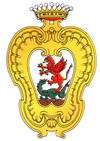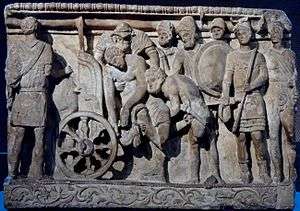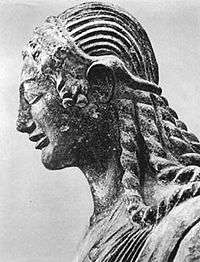Volterra
| Volterra | ||
|---|---|---|
| Comune | ||
| Città di Volterra | ||
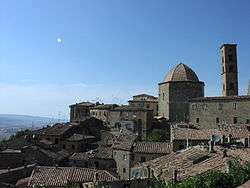 | ||
| ||
 Volterra Location of Volterra in Italy | ||
| Coordinates: 43°24′N 10°52′E / 43.400°N 10.867°ECoordinates: 43°24′N 10°52′E / 43.400°N 10.867°E | ||
| Country | Italy | |
| Region | Tuscany | |
| Province / Metropolitan city | Pisa (PI) | |
| Frazioni | Mazzolla, Saline di Volterra, Villamagna | |
| Government | ||
| • Mayor | Marco Buselli | |
| Area | ||
| • Total | 252 km2 (97 sq mi) | |
| Elevation | 531 m (1,742 ft) | |
| Population (31 June 2009)[1] | ||
| • Total | 11,042 | |
| • Density | 44/km2 (110/sq mi) | |
| Demonym(s) | Volterrani | |
| Time zone | CET (UTC+1) | |
| • Summer (DST) | CEST (UTC+2) | |
| Postal code | 56048 | |
| Dialing code | 0588 | |
| Patron saint | St. Justus | |
| Saint day | June 5 | |
| Website | Official website | |
Volterra is a walled mountaintop town in the Tuscany region of Italy of which its history dates to before the 7th century BC and has substantial structures from the Etruscan, Roman, and Medieval periods. [2]
History

Volterra, known to the ancient Etruscans as Velathri or Vlathri[3] and to the Romans as Volaterrae,[4] is a town and comune in the Tuscany region of Italy. The town was a Bronze Age settlement of the Villanovan culture,[5][6] and an important Etruscan center (Velàthre, Velathri or Felathri in Etruscan, Volaterrae in Latin language), one of the "twelve cities" of the Etruscan League.[7][8]
The site is believed to have been continuously inhabited as a city since at least the end of the 8th century BC.[9][10][11] It became a municipium allied to Rome at the end of the 3rd century BC.[12][13] The city was a bishop's residence in the 5th century,[14] and its episcopal power was affirmed during the 12th century. With the decline of the episcopate, Volterra became a place of interest of the Florentines, whose forces conquered Volterra.[15] Florentine rule was not always popular, and opposition occasionally broke into rebellion. These rebellions were put down by Florence.
When the Florentine Republic fell in 1530, Volterra came under the control of the Medici family and later followed the history of the Grand Duchy of Tuscany.
Main sights
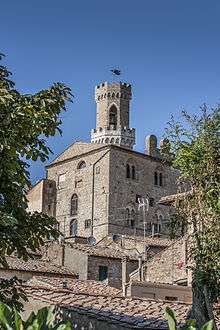
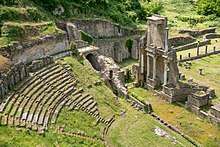
- Roman Theatre of Volterra, 1st century BC, excavated in the 1950s[16][17]
- Piazza dei Priori, the main square, a fine example of medieval Tuscan town squares[18][19][20]
- Palazzo dei Priori, the town hall located on Piazza dei Priori, construction begun in 1208 and finished in 1257[21][22][23]
- Pinacoteca (Art Gallery) in Palazzo Minucci-Solaini.[24][25] Founded in 1905,[26][27] the gallery consists mostly of works by Tuscan artists from 14th to 17th centuries.[28] Includes a Deposition by Rosso Fiorentino.[29][30]
- Volterra Cathedral. It was enlarged in the 13th century after an earthquake. It houses a ciborium and some angels by Mino da Fiesole, a notable wood Deposition (1228), a masterwork of Romanesque sculpture and the Sacrament Chapel, with paintings by Santi di Tito, Giovanni Balducci and Agostino Veracini. In the center of the vault are fragments of an Eternal Father by Niccolò Circignani. Also noteworthy is the Addolorata Chapel, with a terracotta group attributed to Andrea della Robbia and a fresco of Riding Magi by Benozzo Gozzoli. In the nearby chapel, dedicated to the Very Holy Name of Jesus, is a table with Christ's monogram, allegedly painted by Bernardino of Siena. The rectangular bell tower is from 1493.
- Volterra Baptistery of San Giovanni, built in the second half of the 13th century.
- Fortezza Medicea (Medicean Fortress),[31] build in the 1470s,[32] now a prison[33] housing the noted restaurant, Fortezza Medicea restaurant.[34][35][36]
- Guarnacci Etruscan Museum,[37][38] with thousands of funeral urns dating back to the Hellenistic and Archaic periods.[39][40] Main attractions are the bronze statuette "Ombra della sera" (lit. "Shadow of the Night"),[41] and the sculpted effigy, "Urna degli Sposi" (lit. "Urn of the Spouses") of an Etruscan couple in terra cotta.[42][43][44][45]
- The Etruscan City Walls, including the well-preserved Porta all'Arco (3rd-2nd centuries BC),[46][47] and Porta Diana gates.[48][49]
- The Medici Villa di Spedaletto, outside the city, in direction of Lajatico[50]
- There are excavations of Etruscan tombs in the Valle Bona area.
In fiction
- Volterra features in Horatius, a poem by Lord Macaulay.[51][52]
- Linda Proud's A Tabernacle for the Sun (2005), the first volume of The Botticelli Trilogy, begins with the sack of Volterra in 1472. Volterra is the ancestral home of the Maffei family and the events of 1472 lead directly to the Pazzi Conspiracy of 1478. The protagonist of the novel is Tommaso de' Maffei, half brother of one of the conspirators.
- Volterra is an important location in Stephenie Meyer's Twilight series. In the books, Volterra is home to the Volturi, a coven of rich, regal, powerful ancient vampires, who essentially act as the rulers of the world's vampire population. (However, the relevant scenes from the movie were shot in Montepulciano.)
- Volterra is the site of Stendhal's famously disastrous encounter in 1819 with his beloved Countess Mathilde Dembowska: she recognised him there, despite his disguise of new clothes and green glasses, and was furious. This is the central incident in his book On Love.[53][54]
- Volterra is mentioned repeatedly in British author Dudley Pope's Captain Nicholas Ramage historical nautical series. Gianna, the Marchesa of Volterra and the fictional ruler of the area, features in the first twelve books of the eighteen-book series. The books chart the progress and career of Ramage during the Napoleonic wars of the late eighteenth and early nineteenth century, providing readers with well-scripted articulate details of life aboard sailing vessels and conditions at sea of that time.[55][56]
- Volterra is the site where the novel Chimaira by the Italian author Valerio Massimo Manfredi takes place.[57]
- Valerio Massimo Manfredi's The Ancient Curse is also set in Volterra, where a statue called 'The Shade of Twilight' is stolen from the Volterra museum.
- Volterra is featured in Jhumpa Lahiri's 2008 collection of short stories, Unaccustomed Earth. It is where Hema and Kaushik, the protagonists of the final short story "Going Ashore," travel before they part.[58]
- Volterra is featured in Luchino Visconti's 1965 film Sandra.[59]
- Volterra will be featured in 2017 film Fullmetal Alchemist (film) by Hiromu Arakawa.
- 2016 video game The Town of Light is set in the Volterra Psychiatric Hospital.[60]
People
- Persius, (34-62), the Roman satirist of Etruscan stock
- Pope Linus, who, according to the Liber Pontificalis, was born in Volterra, Tuscany, and was the successor to Peter.[61]
- Lucius Petronius Taurus Volusianus, consul with the Emperor Gallienus in AD 261 and Urban Prefect in AD 267-268
- Daniele da Volterra, (1509-1566), Mannerist painter
- The poet Jacopo da Leona was a judge at Volterra in the 13th century.
- The Maffei family of Volterra produced the apostolic Secretary Gherardo Maffei and his three sons: the eldest Antonio Maffei, who was one of the assassins in the Pazzi Conspiracy against the Medici in 1478; second the humanist Raffaello Maffei called "Volterrano" who also served in the Curia; and youngest Mario Maffei, who was also a scholar and followed his father in the curia.
Transport
Volterra has a station on the Cecina-Volterra Railway, called "Volterra Saline – Pomarance" due to its position, in the frazione of Saline di Volterra.[62][63]
Events
The main events that take place during the year in Volterra are
International relations
Twin towns — Sister cities
Volterra is twinned with:
References
- ↑ Data from Istat
- ↑ Lorenzo Aulo Cecina; Flaminio Dal Borgo (1758). Notizie istoriche della città di Volterra, alle quali si aggiunge la serie de' podestà, e capitani del popolo di essa (in Italian). Per G. P. Giovannelli. pp. 65–.
Luglio furono lette alla presenza degli Anziani, e del Consiglio Generale di Volterra le lettere del Conte Guido da Monfort Vicario del Rè, nelle quali veniva comandato, che il Comune di Volterra pagasse ciò, che doveva alla Regia Camera per ...
- ↑ D. H. Lawrence (16 April 2013). Etruscan Places. Read Books Limited. pp. 97–. ISBN 978-1-4474-8782-1.
The great hilltop or headland on which Etruscan "Volterra," Velathri, Vlathri, once stood spreads out jaggedly, with deepcleft valleys in between, more or less in view, spreading two or three miles away. It is something like a hand, the bluff steep ...
- ↑ D. H. Lawrence; Simonetta de Filippis (11 July 2002). Sketches of Etruscan Places and Other Italian Essays. Cambridge University Press. pp. 315–. ISBN 978-0-521-00701-6.
Volterra Velathri in Etruscan, Volaterrae in Latin; it flourished between the 4th and the ist centuries BC. In 298 BC the town yielded without resistance to the Romans and maintained a major role amongst the centres of n. Etruria up to the ...
- ↑ Jean MacIntosh Turfa (13 November 2014). The Etruscan World. Routledge. pp. 134–. ISBN 978-1-134-05523-4.
The lives of many Etruscan cities extend for a millennium or more from the end of the Bronze Age, providing abundant ... Vetulonia, Volterra and probably also Caere, were already occupied in the Final Bronze Age (Protovillanovan period, ...
- ↑ Haynes, Sybille (2005). Etruscan Civilization: A Cultural History. Los Angeles: Getty Trust Publications. p. 30. ISBN 978-0-89236-600-2.
- ↑ Alan Norman Bold (1976). Cambridge Book of English Verse, 1939-1975. CUP Archive. pp. 220–. ISBN 978-0-521-09840-3.
Volterra is a modern town in Tuscany and was once one of twelve cities of Etruria. 1] crack in the stone: like mankind, Volterra stands at the edge of crumbling cliffs. Much of Volterra has dropped down into 'the slow abyss' of erosion.
- ↑ Damgaard Andersen, Helle (1997). Urbanization in the Mediterranean in the 9th to 6th Centuries BC. Copenhagen: Museum Tusculanum Press. p. 344. ISBN 9788772894126.
- ↑ David Bershad; Carolina Mangone; Irving Hexham (2001). The Christian Travelers Guide to Italy. Harper Collins. pp. 220–. ISBN 978-0-310-22573-7.
The famed local industry, working alabaster, has also proved an enduring industry in Volterra. Begun in the 8th century B.C., alabaster carving continues today as the traditional Volterran trade. The prehistoric Villanovan settlement (9th century ...
- ↑ DK (1 May 2014). Eyewitness Travel Family Guide Italy. Dorling Kindersley Limited. pp. 202–. ISBN 978-1-4093-5398-0.
Truly ancient clifftop city Volterra is perhaps the most dramatic and unusual city in the region. Founded by the Etruscans in the 8th century BC, it is perched on a high plateau of volcanic rock and surrounded by medieval walls, some ...
- ↑ Insight Guides (2 November 2015). Insight Guides: Tuscany. APA. pp. 524–. ISBN 978-1-78005-543-5.
These include Etruscan (8th–2nd century BC) sites at Volterra, Fiesole, Arezzo, Chiusi, Vetulonia and on the island of Elba. There is an archaeological museum in Florence, and other museums in Volterra, Chiusi, Cortona, Asciano, Grosseto ...
- ↑ Rural Change and Continuity in Etruria: A Study of Village Communities from the 7th Century B.C. to the 1st Century A.D. ProQuest. 2008. pp. 340–. ISBN 978-0-549-53285-9.
Volterra: A Roman City with an Etruscan Hinterland Rome first reached a settlement with Volterra at the end of the 3rd century B.C. when the city was declared an allied municipium. Volterra only entered fully into the control of Rome with ...
- ↑ Anton Filippo Giachi (1786). Saggio di ricerche sopra lo stato antico e moderno di Volterra dalla sua prima origine fino ai nostri tempi per facilitare ai giovani lo studio della storia patria opera del sacerdote Anton-Filippo Giachi rettore del regio spedale di detta città .. (in Italian). nella stamperia di Pietro Allegrini alla Croce Rossa. pp. 8–.
Ma il colpo fatale dei Romani, e di Volterra fu nell' anno di Roma 474 ... tam bonestum municipium.
- ↑ Christopher Kleinhenz (2 August 2004). Medieval Italy: An Encyclopedia. Routledge. pp. 1038–. ISBN 978-1-135-94880-1.
The lordship of a distant (and often preoccupied) bishop provided many opportunities for civic selfdetermination. On his hill, the bishop of Volterra built a castello as a residence when he was in the area. This, with its church of Santo Stefano, ...
- ↑ Peter Hinze (2000). Florence — Fiesole, Prato, Pistoia, San Gimignano, Volterra, Siena: An Up-to-date Travel Guide ; [with Fold-out Map]. Hunter Publishing, Inc. pp. 7–. ISBN 978-3-88618-773-7.
- ↑ Frank Sear (20 July 2006). Roman Theatres: An Architectural Study. OUP Oxford. pp. 170–. ISBN 978-0-19-814469-4.
J. B. Ward Perkins, BSR 29 (1961), 64, 68. VOLATERRAE (Volterra, PI) (Plan 79, Pis. 35-6) Location: within Roman walls, built against steep slope immediately north of medieval walls. Cavea: D 63 m, facing north-west; ima cavea: 10 rows (o.) ..
- ↑ Rick Steves (28 August 2007). Rick Steves' Florence and Tuscany 2008. Avalon Travel. pp. 354–.
Over time, the theater was forgotten — covered in the garbage of Volterra. Luckily, it was rediscovered in the 1950s. The stage wall was standard Roman design — with three levels from which actors would appear: one for humans, one for ...
- ↑ University of California, Berkeley. Associated Students; Fodor's (1 December 1995). Italy '96: on the loose, on the cheap, off the beaten path. Fodor's Travel Publications. ISBN 978-0-679-02985-4.
.. from here, APT buses go to Volterra (L2200) every 30 minutes. The main oo square in Volterra is Piazza dei Priori, a focal point for ...
- ↑ Mauro Staccioli: Sites of Experience. Damiani. 2009. pp. 167–. ISBN 978-88-6208-117-7.
Piazza dei Priori, Volterra Volterra's main piazza was the center around which Staccioli's 1972 exhibition was organized. A symbol of central power, the piazza is ...
- ↑ Baedekers Autoführer-Verlag (1962). Italy, including Sicily and Sardinia. K. Baedeker. pp. 489–.
... The centre of Volterra is the *Piazza dei Priori, which is lined with medieval palazzi. On the W side, the stately Palazzo dei Priori, ...
- ↑ Mariagiulia Burresi; Alessandro Furiesi; Gabriella Belli (2007). Il Palazzo dei Priori di Volterra: storia e restauro (in Italian). Nuova Immagine. ISBN 978-88-7145-263-0.
- ↑ Inc. Fodor's Travel Publications (2003). Fodor's Florence, Tuscany, and Umbria. Fodor's. pp. 195–. ISBN 978-1-4000-1108-7.
As you make the dramatic climb up to Volterra through bleak, rugged terrain, you'll see that not all ... Piazza dei Priori, lined with an impressive collection of medieval buildings, including the imposing Palazzo dei Priori ...
- ↑ Encyclopedia Americana: Venice to Wilmot. Scholastic Library Pub. 2006. pp. 230–. ISBN 978-0-7172-0139-6.
... In Piazza dei Priori, one of Italy's finest medieval squares, stand the 13th century Palazzo dei Priori or town hall, housing ...
- ↑ Pinacoteca di Volterra (1989). La Pinacoteca di Volterra. Cassa di Risparmio di Firenze.
- ↑ Mariagiulia Burresi; Antonino Caleca (2006). Volterra d'oro e di pietra (in Italian). Pacini. pp. 58–. ISBN 978-88-7781-775-4.
Qui, nel rispetto della sua vocazione a documentare la consistenza dell'arte a Volterra, è stato creato il Museo di palazzo Minucci-Solaini, accostando al primitivo nucleo della Pinacoteca civica di Corrado Ricci, dipinti, sculture e arredi anch ...
- ↑ Lorenzo Carletti; Cristiano Giometti (2001). Scultura lignea pisana: percorsi nel territorio tra Medioevo e Rinascimento. F. Motta. pp. 117–. ISBN 978-88-7179-302-3.
Pinacoteca Civica Dal 1 982 la Pinacoteca di Volterra è ospitata nelle sale del rinascimentale Palazzo Minucci-So- laini, ma la ... annessa al Duomo; quindi, su proposta di Corrado Ricci, nel 1905 la collezione fu spostata nel Palazzo dei Priori e arricchita. ... From 1982 onwards, the Pinacoteca in Volterra has been located in the rooms of the Renaissance Palazzo Minucci- Solaini, but the history of the ...
- ↑ Toscana: (esclusa Firenze) (in Italian). Touring Editore. 1997. pp. 464–. ISBN 978-88-365-0948-5.
A destra, nel breve sdrucciolo di Piazza, è la torre Martinoli, fianco del palazzo Incontri (pag. 459). VIA DANIELE RICCIARELLI (il pittore del '500 più noto come Daniele da Volterra). ... il vicino volto si sbuca nella piazzetta caratterizzata dalla casa-torre Minucci (secolo xm), inglobata nel palazzo Solaini (v. sotto). ... Nucleo fondamentale del complesso museale è la raccolta della Galleria pittorica comunale (Pinacoteca), fondata nel 1905 nel palazzo dei Priori e comprendente un 1 3 IL ...
- ↑ Michelin Travel Publications (2000). Tuscany. Michelin Travel Publications. pp. 313–. ISBN 978-2-06-000010-7.
Volterra crags (baize) Pinacoteca 0 - Via dei Sarti 1 ; in the Palazzo Minucci-Solaini. The art gallery has some interesting works of religious art by Tuscan masters of the 14C-17C ...
- ↑ Anna Benvenuti Papi (1999). Volterra e la Val di Cecina (in Italian). Mondadori. ISBN 978-88-04-46773-1.
Dal 1982 la Galleria Pittorica, o Pinacoteca, è ospitata nelle sale del palazzo Minucci-Solaini, esempio notevole di ... Tra le opere più significative segnaliamo, oltre la celebre e grandiosa tavola della Deposizione del Rosso Fiorentino, polittici ...
- ↑ Harvard Student's; Let's Go, Inc. (1999). Let's Go: the Budget Guide to Italy. St. Martin's Press. pp. 299–.
Volterra's Fortezza Medicea, an elegant remnant from the Florentine domination, is the town's most prominent structure. ... On the other side of P. dei Priori, on V. dei Sard, the Pinacoteca Comunale occupies the Palazzo Minucci-Solaini (tel. ... In his Deposition (1520), the most significant piece of the collection, Rosso Fiorentino appears to abandon High Renaissance ...
- ↑ Denbigh Sale; Marie Kidd; Julian Pitt (1 December 2014). Our Secret Tuscany: In the Foothills of Monte Pisano. Australian eBook Publisher. pp. 53–. ISBN 978-1-925271-65-2.
Although Volterra isn't strictly in the region of the Monte Pisano, we highly recommend a visit to this atmospheric hilltown which ... From its commanding hilltop position, the enormous Medici Fortress (Fortezza Medicea) looks out over Volterra.
- ↑ Dana Facaros; Michael Pauls (2004). Italy. New Holland Publishers. pp. 685–. ISBN 978-1-86011-113-6.
... in the 'archaeological park' near the Fortezza Medicea, a big castle built on what was the Etruscan acropolis in the 1470s. ... Volterra 's most conspicuous ancient relic, however, is the Etruscan arch in the south wall, over Via Porta all'Arco.
- ↑ Rachael Hamilton; Allison Macleod; Jenny Munro (18 July 2014). Spaces of (Dis)location. Cambridge Scholars Publishing. pp. 164–. ISBN 978-1-4438-6451-0.
Volterra's identity was not only characterized by its tradition of alabaster craft and by the psychiatric hospital, but also by the high security penitentiary located in the Fortezza Medicea. The Duke of Florence, Lorenzo il Magnifico, constructed the ...
- ↑ Orth, Stephan (10 September 2007). "Gefängnis Volterra: Zu Gast bei Ganoven". Spiegel Online. Retrieved 30 January 2012.
- ↑ Gumuchian, Marie-Louise (20 May 2008). "Guests give top marks to Italian gourmet jail". Reuters. Retrieved 30 January 2012.
- ↑ Pisa, Nick (20 May 2007). "'They made me a pasta I couldn't refuse'". The Daily Telegraph. Retrieved 30 January 2012.
- ↑ Gabriele Cateni (2004). Volterra: The Guarnacci Etruscan Museum. Pacini. ISBN 978-88-7781-622-1.
- ↑ Brief guide to the Guarnacci Etruscan Museum of Volterra. Edizioni I.F.I. 1970.
- ↑ Anna Marguerite McCann; Metropolitan Museum of Art (New York, N.Y.) (1978). Roman Sarcophagi in the Metropolitan Museum of Art. Metropolitan Museum of Art. pp. 58–.
Etruscan ... Cf. particularly the stern of a galley represented on an Etruscan funerary urn in the Guarnacci Museum in Volterra, Pairault, op. cit, pl. 1142.' Also see the ...
- ↑ The J. Paul Getty Museum (1 January 1981). The J. Paul Getty Museum Journal: Volume 9, 1981. Getty Publications. pp. 55–. ISBN 978-0-89236-032-1.
...in keeping with the gradual proliferation of large~sca1e sculpture throughout Etruria from the end of the fourth and beginning of ... Evidence for North Etruscan workmanship is offered by the reliefs on cinerary urns of Volterra, Chiusi, and Perugia, and the sculptural ... Museo Etrusco Guarnacci, inv. no.
- ↑ Eric Russell Chamberlin; Ken Paterson; Thomas Cook Ltd (1994). Passport's Illustrated travel guide to Florence & Tuscany. Passport Books. ISBN 978-0-8442-9055-3.
MUSEO ETRUSCO GUARNACCI This is one of the most important museums of Etruscan art in Italy. ... as the 'Shadow of the Night', discovered in 1879 and used as a firepoker until experts realised this was a masterpiece of Etruscan art.
- ↑ Rick Steves (29 December 2015). Rick Steves Snapshot Hill Towns of Central Italy: Including Siena & Assisi. Avalon Travel Publishing. pp. 94–. ISBN 978-1-63121-204-8.
The museum's other top piece is the Urn of the Spouses (Urna degli Sposi, first century B.C.). It's unique for various reasons, including its material (it's in terracotta—a relatively rare material for these funerary urns) and its depiction of two ...
- ↑ Florence and Tuscany. A complete guide with itineraries. ATS Italia Editrice. 2011. pp. 64–. ISBN 978-88-6524-400-5.
Among the works housed here, particularly remarkable are: the vase with black figures, the cinerary urn with the deceased (Atteone), the mirror with dioscuri and the Urn of the spouses. Volterra Guarnacci Etruscan Museum, Evening Shadow ...
- ↑ Kunst und Geschichte der Toskana: ein Landstrich voller Wohlgeschmack und Farbenfreude eine Region, in der die gastronomische Überlieferung auf magische Weise mit einer jahrtausendealten Kultur verbunden ist (in German). Casa Editrice Bonechi. 1970. pp. 91–. ISBN 978-88-476-1794-0.
SCHATTEN DES ABENDS Museo Etrusco Guarnacci Die Figur stammt aus der Florentiner Sammlung der Familie Buonarroti und wurde von ... Unten der Deckel einer Aschenurne, der sogenannten Urna degli Sposi (des Ehepaares
- ↑ Touring Club of Italy (2005). Authentic Tuscany. Touring Editore. pp. 72–. ISBN 978-88-365-3297-1.
The Museo Etrusco Guarnacci O has forty rooms housing an enormous collection of antiquities from prehistoric to ... alabaster and terracotta (4th-1st century BC) from local excavations, including the famous Urna degli Sposi (Urn of the Married ...
- ↑ George Dennis (1848). The Cities and Cemeteries of Etruria. John Murray. pp. 146–.
Volterra. He may know it by the sign of three naked females, the most graceless things about the house. The landlord, SigTM. Ottavio ... From the "Unione," a few steps will lead to the Porta all' Arco.3 I envy the stranger his first impressions on ...
- ↑ Henry James (1 March 1995). Italian Hours. Penguin Publishing Group. pp. 339–. ISBN 978-1-101-17386-2.
I may not invite the reader to penetrate with me by so much as a step the boundless backward reach of history to which the more massive of the Etruscan gates of Volterra, the Porta all'Arco, forms the solidest of thresholds; since I perforce take ...
- ↑ Mario Giovannelli (1613). Cronistoria dell'antichità, e nobiltà di Volterra, cominciando dal principio della sua edificazione infin'al giorno d'hoggi. ... Raccolta da diuersi scrittori per ... fra Mario Giouannelli .. appresso Giouanni Fontani. pp. 4–.
- ↑ Luisa Banti (1973). Etruscan Cities and Their Culture. University of California Press. pp. 146–. ISBN 978-0-520-01910-2.
These natural communication routes all met just below the city, where the village of Saline di Volterra stands today. Then as now, Volterra ... The two city gates — Porta Diana and Porta all'Arco — are Etruscan only in their lower part. The three ...
- ↑ Isabella Lapi Ballerini; Mario Scalini (2003). The Medici Villas: Complete Guide. Giunti Editore. pp. 84–. ISBN 978-88-09-02995-8.
- ↑ David Gilmour (3 March 2011). The Pursuit of Italy: A History of a Land, its Regions and their Peoples. Penguin Books Limited. pp. 46–. ISBN 978-0-14-192989-7.
... who were based in Etruria, where they built hilltop towns such as Volterra, and from where they spread north to the Po ... historian Livy, Thomas Babington Macaulay described the Roman hero Horatius Cocles holding a bridge over 'Father ...
- ↑ James Bentley (5 July 1988). A guide to Tuscany. Penguin. pp. 18–. ISBN 978-0-14-046683-6.
Macaulay's poem 'Horatius' has as its hero a Roman, not the ranks of Lars Porsena invading the city of Rome. Even so Macaulay perfectly catches in his verse ... It took him two years to starve out Volterra. Then Sulla made himself dictator and ...
- ↑ F. C. Green (16 June 2011). Stendhal. Cambridge University Press. pp. 142–. ISBN 978-1-107-60072-0.
In May of 1819, Métilde went to Volterra where her two sons were at school, whilst Stendhal reproached himself bitterly for not having had the courage to demand a decisive explanation of her feelings. But as he wrote rather pathetically: " Mais ...
- ↑ David Wakefield (1984). Stendhal: The Promise of Happiness : "la Beauté N'est Que la Promesse Du Bonheur" (De L'Amour). Newstead Press. pp. 43–. ISBN 978-0-85390-027-6.
At the time she met Stendhal early in 1818 she was living on the piazza Belgiojoso. From the ... Then, in the Spring of 1819, Metilde announced that she was going to visit her sons at school in Volterra, and she forebade Stendhal to follow her.
- ↑ Sue Parrill (31 August 2009). Nelson's Navy in Fiction and Film: Depictions of British Sea Power in the Napoleonic Era. McFarland. pp. 209–. ISBN 978-0-7864-5803-5.
Ramage (1965) #1 Pope's first novel introduces the hero, Lord Nicholas Ramage, lieutenant in the Royal Navy, in the year ... The friends of his family include the Marchesa di Volterra, whom Ramage learns is one of the six noble refugees that ...
- ↑ Tom Grundner (1 October 2007). The Ramage Companion. Fireship Press. pp. 1–. ISBN 978-1-934757-05-5.
Lieutenant Lord Nicholas Ramage wakes up a dazed and confused young man. ... Landing himself and his men, he rescues the stranded refugees—in- cluding the beautiful Marchesa di Volterra—literally from under the hoofs of Napoleon's ...
- ↑ Panorama (in Italian). 1826-1829. Mondadori. April 2001. pp. 223–.
CHIMAIRA di Valerio Massimo Manfredi Mondadori, 246 pagine, 30 mila lire. ... con Nino Castelnuovo che perdeva la testa per una bella etrusca reincarnatasi nella Volterra dei giorni nostri.
- ↑ Anjali Pandey (25 January 2016). Monolingualism and Linguistic Exhibitionism in Fiction. Palgrave Macmillan UK. pp. 165–. ISBN 978-1-137-34036-8.
... they saw, lined on the shelves, hundreds of urns in which the ancient people of Volterra had stored the ashes of their dead. ... The following interaction excerpted from "Unaccustomed Earth" illustrates how Lahiri manages to 'explain' Bengali ...
- ↑ Henry Bacon (28 March 1998). Visconti: Explorations of Beauty and Decay. Cambridge University Press. pp. 120–. ISBN 978-0-521-59960-3.
Another starting point was d'Amico's and Visconti's idea of locating the story in the Tuscan city of Volterra. ... Sandra (Cardinale) suspects her mother (Marie Bell) and the mother's lover Gilardini (Renzo Ricci) of betraying her Jewish father to ...
- ↑ Adam Smith (2016-01-29). "True Horror: The Town Of Light’s Historical Inspirations". Rock, Paper, Shotgun. Retrieved 2017-05-14.
- ↑ "Catholic Online". Catholic Online. Retrieved 2 January 2017.
- ↑ Emma Jones (1 April 2004). Tuscany and Umbria. Hunter Publishing, Inc. pp. 308–. ISBN 978-1-58843-399-2.
The. wide fertile valley of the Valdera (the Era Valley) spreads along the Era River ... Saline di Volterra is on the Pisa-Cecina-Volterra Saline train line (% 848-888088, www.trenitalia.it); a shuttle bus will take ...
- ↑ Gillian Price (27 July 2012). Walking in Tuscany: 50 Walks throughout Tuscany. Cicerone Press Limited. pp. 80–. ISBN 978-1-84965-672-6.
By public transport from Volterra take the local bus for the short ride down to Saline. Otherwise from Cecina on the main LivornoRome rail line, several trains a day (or the odd substitute bus) still run as far as Saline. 7: Saline di Volterra, ...
- ↑ Lonely Planet (24 July 2014). Italie 6 - Florence et la Toscane (in French). Place Des Editeurs. pp. 226–. ISBN 978-2-8161-4727-8.
Volterragusto GASTRONOMIE (www.volterragusto.com). Manifestations à la mi-mars, à la fin octobre et début novembre, présentant des produits locaux, notammentdufromage, destruffes blanches, de l'huile d'olive et du chocolat.
- ↑ Madelena Gonzalez; Patrice Brasseur (16 April 2010). Authenticity and Legitimacy in Minority Theatre: Constructing Identity. Cambridge Scholars Publishing. pp. 138–. ISBN 978-1-4438-2184-1.
... depuis 1996, le théâtre San Pietro à Volterra, a obtenu, à partir de 1997, la direction artistique et technique du festival Volterrateatro, au sein duquel le projet « Iteatri dell'impossibile » a été proposé.5 Cette compagnie apporte régulièrement ...
External links
| Wikimedia Commons has media related to Volterra. |
- Official website
- Harris, W., R. Talbert, T. Elliott, S. Gillies. "Places: 403292 (Velathri/Volaterrae)". Pleiades. Retrieved March 7, 2012.
